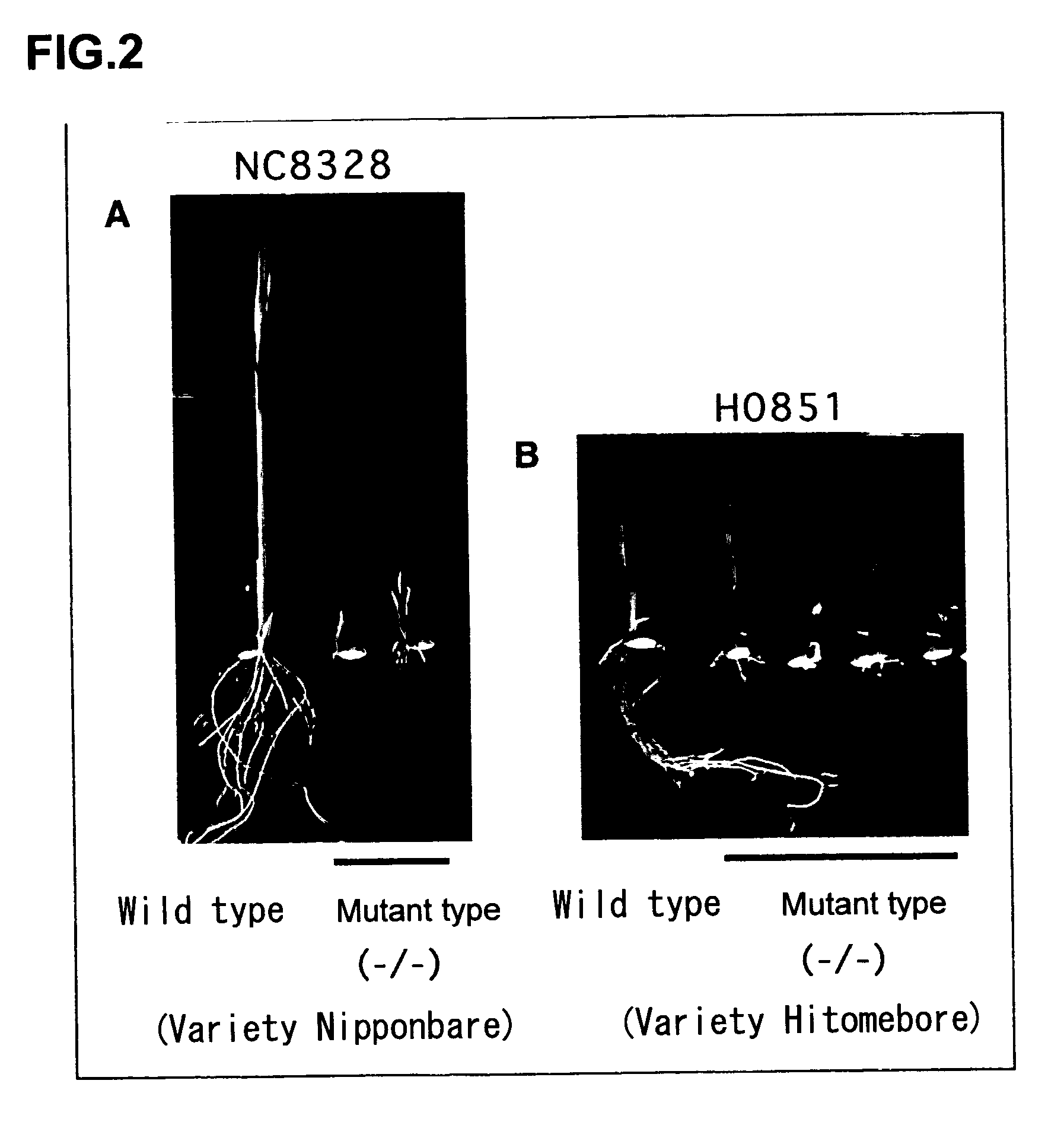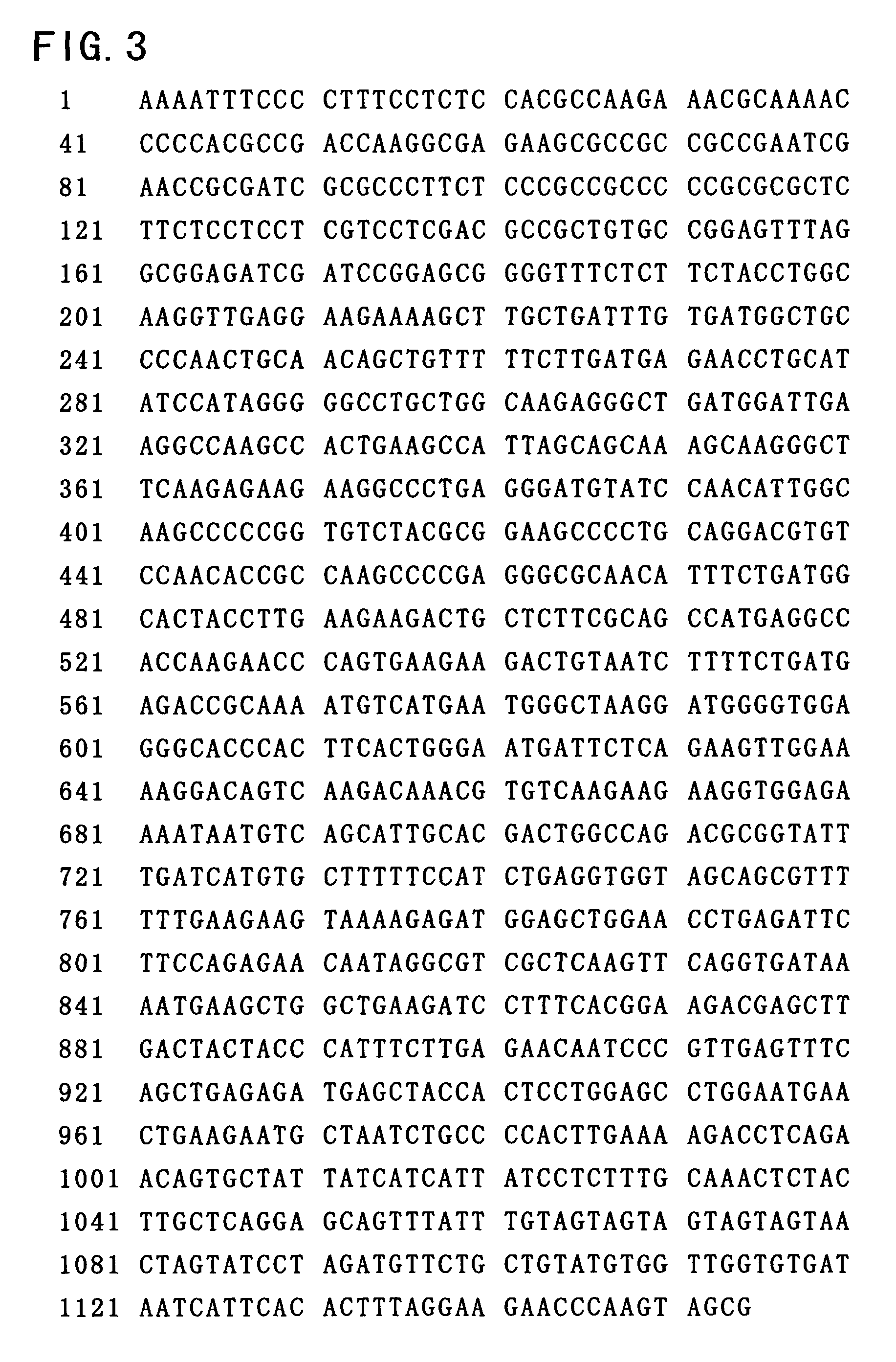Rice gene for controlling tolerance to salt stress
- Summary
- Abstract
- Description
- Claims
- Application Information
AI Technical Summary
Benefits of technology
Problems solved by technology
Method used
Image
Examples
example 1
Activation of Tos17 by Culture and Characterization of Resultant Mutants
[0084]Mature seeds of “Nipponbare”, “Hitomebore”, or the like (varieties of species Japonica) were used as starting material to conduct callus initiation culture and cell suspension culture, as described in Hirochika et al., 1996, Proc. Natl. Acad. Sci. USA, 93, 7783–7788) (supra). Culture conditions for activating Tos17 used in gene disruption were determined in accordance with Otsuki's method (1990) (Rice protoplast culture, Agriculture, Forestry and Fisheries Technical Information Society).
[0085]Briefly, mature seeds of rice were cultured in MS medium containing 2,4-dichlorophenoxyacetic acid (2,4-D) (Otsuki (1990), supra) (25° C., 1 month) so as to induce calluses. The resultant calluses were cultured in N6 liquid medium containing 2,4-D (Otsuki (1990), supra) for 5 months, and were transferred to redifferentiation medium (Otsuki (1990), supra) to obtain redifferentiated rice (first generation (R1) plant).
[0...
example 2
Isolation of Flanking Sequence to Tos17
[0088]In order to find a gene which controls the phenotype observed in Example 1, a flanking sequence to Tos17, which had been transferred into genomic DNA, was isolated.
[0089]DNA was prepared from the R2 rice (strain ND1004) obtained in Example 1 by a CTAB method (Murray and Thompson, 1980, Nucleic Acids Res. 8, 4321–4325). A Tos17 target site sequence was amplified by reverse PCR using total DNA as previously described (Hirochika et al., 1996, supra; and Sugimoto et al., 1994, Plant J., 5, 863–871).
[0090]Briefly, about 0.5. mu.g of total DNA from a mutant plant (strain ND1 004− / −), in which Tos17 was inserted into a target site by transposition, was initially digested with Xbal. The digested DNA was extracted with phenol / chloroform, followed by ethanol precipitation for purification. Thereafter, T4 DNA ligase was used to carry out ligation at 12. degree. C. overnight with a total volume of 300. mu.l. Ligated DNA was purified, one third of whi...
example 3
Structural Analysis of Causative Gene in Mutant
[0091]RNA was prepared from seedlings of wild type rice (Nipponbare) grown in soil for 11 days in the manner below. Initially, ISOGEN solution was used to extract total RNA from the seedlings. The total RNA was applied to an oligo(dt)cellulose column included in a mRNA purification kit (Stratagene) to obtain poly(A) mRNA. cDNA was synthesized from the resultant poly(A) mRNA by a commonly used method. A cDNA library was constructed in HybriZAP-2.1 vectors (Stratagene). The cDNA library had an infection ability of 5×105 plaques. In vivo cleavage of pBluescript plasmid including cDNA inserted fragments was conducted using Escherichia coli strain XL1-Blue MRF2.
[0092]The cDNA library was subjected to screening in accordance with a method described in Molecular Cloning, A Laboratory Manual (Sambrook et al., 1989), where the reverse PCR products of the flanking sequence to Tos17, which were obtained in Example 2, were used as probes.
[0093]From...
PUM
| Property | Measurement | Unit |
|---|---|---|
| Temperature | aaaaa | aaaaa |
| Temperature | aaaaa | aaaaa |
| Fraction | aaaaa | aaaaa |
Abstract
Description
Claims
Application Information
 Login to View More
Login to View More - R&D
- Intellectual Property
- Life Sciences
- Materials
- Tech Scout
- Unparalleled Data Quality
- Higher Quality Content
- 60% Fewer Hallucinations
Browse by: Latest US Patents, China's latest patents, Technical Efficacy Thesaurus, Application Domain, Technology Topic, Popular Technical Reports.
© 2025 PatSnap. All rights reserved.Legal|Privacy policy|Modern Slavery Act Transparency Statement|Sitemap|About US| Contact US: help@patsnap.com



